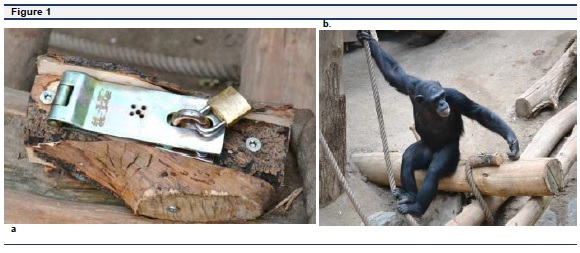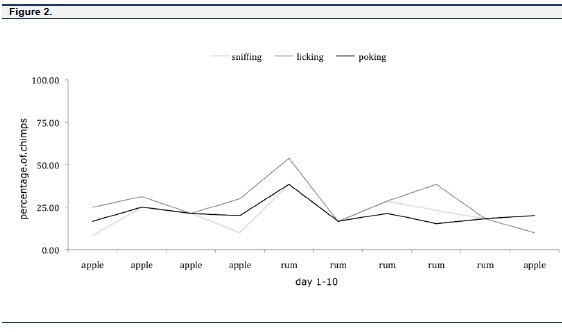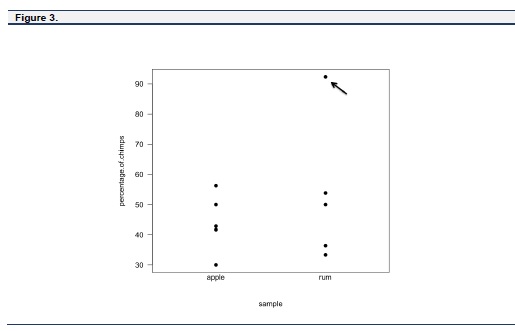Services on Demand
Journal
Article
Indicators
-
 Cited by SciELO
Cited by SciELO -
 Access statistics
Access statistics
Related links
-
 Cited by Google
Cited by Google -
 Similars in
SciELO
Similars in
SciELO -
 Similars in Google
Similars in Google
Share
International Journal of Psychological Research
Print version ISSN 2011-2084
int.j.psychol.res. vol.9 no.2 Medellín Jul./Dec. 2016
https://doi.org/10.21500/20112084.2299
DOI: http://dx.doi.org/10.21500/20112084.2299
Research
Do chimpanzees like alcohol?
¿Les gusta el alcohol a los Chimpancés?
Ruth Thomsena* and Anja Zschokeb
a University College London, Department of Anthropology, Gower Street, London, United Kingdom.
b Max Planck Institute for Evolutionary Anthropology, Department of Primatology, Leipzig, Germany.
* Corresponding author: Ruth Thomsen, Department of Anthropology, University Collage London, London, United Kingdom. WC1E86BT, Email address: ruth.thomsen@ucl.ac.uk
Article history:
Received: 08-04-2016. Revised: 20-06-2016. Accepted: 29-06-2016.
ABSTRACT
In the last common ancestor of modern humans and the three living African ape species a genetic mutation occurred that increased the rate that alcohol was metabolized. This fact initially supports the "drunken monkey hypothesis" which states that natural selection should have favoured individuals that routinely incorporated alcohol- and thus energy-rich fruits into their diet. However, random observations from apes living in the wild do not provide evidence for such kind of choosey feeding behaviours. To investigate whether or not the living great apes have evolved a preference of alcohol-rich fruits over normal ripe fruits we performed a bioassay with captive chimpanzees offering them apple puree with and without rum flavour. Initially, the chimpanzees were curious about the alcohol-flavoured apple puree and feed on it when it was presented to them for the very first time. Once tasted, however, they lost interest in it indicating that chimpanzees are able to perceive, but do not prefer alcohol-rich fruits more than non-alcoholic fruits. Thus, we think that for our hominoid ancestors from the late Miocene the possibility to consume alcohol-rich fruits was helpful to survive periods of food scarcity, but did not lead to a genetic predisposition for alcohol.
Key words: great ape evolution, alcohol, chimpanzees, Pan troglodytes, bioassay.
RESUMEN
En los últimos ancestros comunes de los humanos modernos y las tres especies vivientes de simios africanos, se produjo una mutación genética que aumenta la tasa en la que el alcohol es metabolizado. Este hecho apoya inicialmente la hipótesis del “mono ebrio”, la cual establece que la selección natural podría haber favorecido a los individuos que habitualmente incorporaban en su dieta el alcohol y por lo tanto frutos con alto contenido calórico. Sin embargo, las observaciones realizadas al azar en simios que viven en estado silvestre, no proporcionan evidencia para la selección de este tipo de preferencias alimentarias. Para investigar si los grandes simios han evolucionado a una mayor preferencia de frutas asociadas con la producción de alcohol sobre las frutas maduras normales, llevamos a cabo un bioensayo con chimpancés en cautiverio ofreciéndoles puré de manzana con y sin sabor a ron. Inicialmente los chimpancés tuvieron curiosidad sobre el puré de manzana saborizado con alcohol y lo consumieron cuando se les ofreció por primera vez. Sin embargo, una vez probado perdieron el interés, indicando que los chimpancés son capaces de percibir el alcohol, pero no prefieren las frutas asociadas con la producción de alcohol sobre las frutas sin alcohol. Por lo tanto, creemos que, para nuestros antepasados homínidos del Mioceno tardío, la posibilidad de consumir frutas ricas en alcohol fue útil para sobrevivir a períodos de escasez de alimentos, pero no condujo a una predisposición genética para el alcohol.
Palabras clave: gran simio, evolución, alcohol, chimpancés, Pan troglodytes, bioensayo.
1. INTRODUCTION
The predisposition for alcohol in modern humans is supposed to be originated approximately 10 mya when in the last common ancestor of modern humans and the three living African ape species a genetic mutation occurred that increased by 40-fold the rate that alcohol (ethanol) was metabolized (Carrigan et al. 2015). This finding initially supports the "drunken monkey hypothesis" which states that natural selection should have favoured individuals that routinely incorporated alcohol-rich fruits into their diet because alcohol-rich fruits have twice as much energy than normal ripe fruits (Dudley 2000 ; 2004). Frankly said, monkeys that were regularly drunk to some degree are thought to have had an evolutionary advantage over individuals (or species) who remain sober over time.
In nature, animal species other than non-human primates and such diverse as, for instance, birds (Fitzgerald et al. 1990) or elephants (Siegel and Brodie 1984) are known to randomly consume alcohol-rich fruits. However, from non-human primates including the African apes, who are studied already for decades in their natural habitats, there is only one report available which is describing a very small population of Western chimpanzees (Pan troglodytes verus) in a highly destroyed habitat while consuming fermenting palm wine (Ø 3.1%) that was produced and placed in the trees by humans (Hockings et al. 2015).
The common diet of non-human primates living in the wild does not regularly contain alcohol. Whenever there is a choice, animals seem to prefer fresh non-alcoholic fruits over rotten alcohol-rich fruits. This fact, together with a lack of observations on wild living primates that would regularly consume alcohol-rich fruits (Milton 2004), leads to the assumption that during hominoid evolution alcohol-rich fruits were consumed, if ever, only as fallback food during periods of scarcity when there was no other food available.
To investigate whether or not the living great apes have evolved a preference of alcohol-rich fruits over ripe fruits we performed a bioassay with captive chimpanzees offering them apple puree with and without rum flavour. If chimpanzees do not like and prefer alcohol-rich fruits over fresh fruit the lively interest for alcohol known in modern human societies (Dudley 2004) probably has started independently from hominoid feeding habits sometime later during human evolution.
2. ANIMALS AND METHODS
2.1 Animals
Western chimpanzees inhabit the tropical rainforests of Western Africa. They form large multi-male multi-female groups of approximately 20-200 individuals where males are the philopatric sex and females disperse from their natal group. Chimpanzees build fission-fusion societies whereby the main group occasionally splits up into smaller feeding parties and later fuses again (Boesch 2012). They are omnivores preferentially feeding on fruit for more than 75% of their total feeding time in some habitats (Watts et al. 2012) and their cultures in the wild are famous for sophisticated tools use that includes poking sticks (Whiten et al. 1999).
To successfully forage in a three-dimensional environment, chimpanzees have to find fruits of best nutritional quality via visual (colour) and olfactory (odour plume) cues. During the ripening process of fruits the colour changes, the texture gets softer and the starch is converted first into sugar and when the process of rotting starts yeast ferments the sugar into different alcohols of concentrations from approximately 0.04-0.72% (Levey 2004).
2.2 Study Site
We studied captive chimpanzees from Wolfgang-Koehler Primate Research Center (WKPRC) located inside Zoo Leipzig, Germany. The social intact group consisted of 6 males and 11 females between 3-36 years. In accordance with the recommendations of the Weatherall report “The use of non-human primates in research” the group of apes had access to a semi-natural indoor (417m²) and an outdoor (4125m²) enclosure containing climbing structures, such as ropes and platforms and natural features, such as vegetation, trees and streams. They received regular feedings, had access to enrichment devices including shaking boxes and poking bins, and water ad libitum. Research was conducted in the indoor enclosure and all subjects voluntarily participated in the study.
No medical, toxicological or neurobiological research of any kind is conducted at the WKPRC. Research was non-invasive and strictly adhered to the legal requirements of Germany. The study was approved from an internal ethical committee at the Max Planck Institute for Evolutionary Anthropology. Animal husbandry and research comply with the “EAZA Minimum Standards for the Accommodation and Care of Animals in Zoos and Aquaria”, the “WAZA Ethical Guidelines for the Conduct of Research on Animals by Zoos and Aquariums” and the “Guidelines for the Treatment of Animals in Behavioral Research and Teaching” of the Association for the Study of Animal Behavior (ASAB). IRB approval was not necessary because no special permission for the use of animals in purely behavioural or observational studies is required in Germany by law (TierSchGes §7 and §8).
2.3 Bioassay
We used apple puree (Golden Valley®) as a substitute for ripe fruits and prepared it with rum flavour (Oetker®) to imitate both the odour and taste of alcohol-rich fruits. Over a period of 10 days fresh puree was filled into a cup (40mL) and placed in a little box with 5 holes that was adjusted on a tree trunk inside the daytime enclosure to allow the chimpanzees to sniff, lick, and poke with sticks whenever (Figures 1a and b). To test chimpanzees' interest in alcohol we adjusted a common habituation/dishabituation paradigm appropriate for apes (Hepper and Wells 2012). During days 1-4 we offered pure apple puree, during days 5-9 we added rum flavour (200µL, to reach an alcohol concentration of 0.5%), and on day 10 we offered pure apple puree again.
2.4 Video Records and Analysis
In the morning hours when the chimpanzee group was used to enter the large indoor enclosure, we video recorded for the duration of 1 hour all behavioural responses towards the presented substances (Table 1). For video analysis we used a frame-by-frame analysis tool from the software Mangold Interact (Version 8.4.7).
2.5 Statistical Analysis
We counted all defined behavioural responses per individual per day. Since some individuals sometimes were joining other experiments in WKPRC, we used the percentage of individuals present in the enclosure for further analysis to run statistical tests in R (version 13.2.1). The alpha value was set at 5% (Sachs 2004).
3. RESULTS
In total, the chimpanzees sniffed 27 times and made 62 trials to feed on the apple puree by directly licking the box or using poking sticks. During the 10 days, a peak in the number of chimpanzees that showed behavioural responses occurred on day 5, the first day when the apple puree was enriched with rum flavour (Figure 2). More than 90% of the individuals present approached the box to sniff or taste the new flavour (Figure 3, arrow).
From days 6-9 the chimpanzees' interest came back to the level that they showed towards the pure apple puree during the first days. Thus, chimpanzees are able to perceive alcohol of low concentrations but do not significantly prefer alcohol-enriched apple puree (randomized ANOVA, p>0.05). Overall, we also found no difference in the mean number of individuals that sniffed, licked or poked on pure apple puree compared to that enriched with rum flavour (Kruskal-Wallis-test, x2=0.176, df=1, p=0.67).
4. DISCUSSION
As shown in our study, chimpanzees are able to distinguish ripe fruit from alcohol-rich fruit via olfactory and gustatory cues. During a habituation/dishabituation test, the chimpanzees initially were curious about the alcohol-flavoured apple puree and more than 90% of the individuals tried to feed on it when it was presented to them for the first time. Once tasted, however, the individuals lost their temporarily enhanced interest in it. This pattern leads to the conclusion that chimpanzees are able to perceive but do not prefer the taste of alcohol-rich over non-alcoholic fruits.
Chimpanzees share around 99.5% of their active coding DNA with modern humans (Goodman 1999) including ADH4, the ethanol-digesting enzyme alcohol dehydrogenase-4 (Benner 2013). This is the first enzyme exposed to ethanol in the digestive tract that is capable of metabolizing ethanol. It was identified as a single mutation occurring approximately 10 mya that endowed the three living African apes (chimpanzees, bonobos (Pan paniscus) and gorillas (Gorilla gorilla)) as well as our species (Homo sapiens) with a markedly enhanced ability to metabolize ethanol (Carrigan et al. 2015). Since during mid Miocene the climate in Africa became colder and drier coming along with a reduced number of trees and scarcity in fruits, the ability to digest rotten, alcohol-rich fruits probably offered a nutritional advantage over those hominoid species that did not develop such a mutation. This fact may help partly to explain the yet unsolved question why only three of the former approximately hundred ape species (or 14 genera) survived these severe environmental changes during Miocene (Begun 2007).
Nevertheless, our study further shows that chimpanzees are able to smell and taste but do not prefer alcohol-rich fruit over fresh fruit. This can be explained by the fact that the proposed benefit of gaining more energy did not outweigh physiological and cognitive costs of alcohol consumption during the course of hominoid evolution. For wild living non-human primates "to be drunk" probably comes along with the same problems known from modern humans. Alcohol negatively impairs basic features of placentalias' reproduction such as semen quality (Martini et al. 2004) as well as embryonic brain development (Brown et al. 1979). Assigned to wild living great apes, being drunk consequently also would mean to become more vulnerable to predators, to lose neural control during climbing or tool use as well as to suffer from reduced cognitive and social skills.
Summarized, we argue that for our hominoid ancestors from the late Miocene the consumption of alcohol was, just as it seems nowadays for the chimpanzees of Bossou (Hockings et al. 2015 ), one of the keys to survive periods of food scarcity. However, since at the least extant chimpanzees neither seem to prefer nor really like alcohol, we argue that hominoids did not evolve a genetic preference for alcohol probably because alcohol consumption is adaptive only as long as it is not constantly overdosed. Or in other words, "drunken monkeys" were not able to survive natural selection.
5. ACKNOWLEDGEMENTS
We thank the caretakers from WKPRC and Susann Schunack for providing us with information on the chimpanzee group and for kind support throughout the study. Ruth Thomsen appreciated fruitful discussions with Josep Call on olfactory behaviours of the Leipzig apes and further thanks Christophe Boesch for the opportunity to stay from 2013-2015 as a guest researcher at the Max Planck Institute of Evolutionary Anthropology, Department of Primatology, Anja Zschoke was financed by a grant from the German Society of Primatologists (Gesellschaft für Primatologie, GfP) and thanks Volker Sommer to be hosted at University College London during her apprenticeship.
6. REFERENCES
Begun DR. 2007. Fossil record of miocene hominoids. In: Henke W & Tattersall I: Handbook of Paleoanthropology. Springer, p. 921-977. [ Links ]
Benner SA. 2013. Paleogenetics and the history of alcohol in primates. Annual Meeting of AAAS, 14-18 February, Boston. [ Links ]
Brown NA, Goulding EH, Fabro S. 1979. Ethanol embryotoxicity: direct effects on mammalian embryos in vitro. Science 206: 573-575. [ Links ]
Boesch, C. (2012). The Ecology and Evolution of Social Behavior and Cognition in Primates. In The Oxford Handbook of Comparative Evolutionary Psychology. Rochester, MI, United States. [ Links ]
Carrigan MA, Uryasev O, Frye CB, Eckman BL, Myers CR, Hurley TD, Benner SA. 2015. Hominids adapted to metabolize ethanol long before human-directed fermentation. Proceedings of the National Academy of Sciences112 (2): 458-463. [ Links ]
Dudley R. 2000. Evolutionary origins of human alcoholism in primate frugivory. The Quarterly Review of Biology75 (1): 3-15. [ Links ]
Dudley R. 2004. Ethanol, fruit ripening, and the historical origins of human alcoholism in primate frugivory'. Integrative and Comparative Biology44 (4): 315-323. [ Links ]
Fitzgerald SD, Sullivan JM, Everson RJ. 1990. Suspected ethanol toxicosis in two wild cedar waxwings. Avian Diseases34 (2): 488-490. [ Links ]
Goodman M. 1999. The genomic record of humankind's evolutionary roots'. The American Journal of Human Genetics64 (1): 31-39. [ Links ]
Hepper PG, Wells DL. 2012. Olfactory discrimination in the western lowland gorilla, (Gorilla gorilla gorilla). Primates53 (2): 121-126. [ Links ]
Hockings KJ, Bryson-Morrison N, Carvalho S, Fujisawa M, Humle T, McGrew W, Nakamura M, Ohashi G, Yamanashi Y, Yamakoshi G, Matsuzawa T. 2015. Tools to tipple: ethanol ingestion by wild chimpanzees using leaf-sponges. Royal Society Open Science, 9 June 2015. DOI: 10.1098/rsos.150150. [ Links ]
Levey DJ. 2004. The evolutionary ecology of ethanol production and alcoholism. Integrative and Comparative Biology44 (4): 284-89. [ Links ]
Martini AC, Molina RI, Estofan D, Senestrari D, Fiol de Cueno M, Ruiz RD. 2004. Effects of alcohol and cigarette consumption on human seminal quality. Fertility & Sterility82: 374-377. [ Links ]
Milton K (2004) Ferment in the family tree: Does a frugivorous dietary heritage influence contemporary patterns of human ethanol use? Integrative and Comparative Biology44(4): 304-314. [ Links ]
R Core Team 2013. R: A language and environment for statistical computing. Vienna, Austria: R Foundation for Statistical Computing. [ Links ]
Sachs L. 2004. Angewandte Statistik: Anwendung statistischer Methoden. Berlin, Springer press. [ Links ]
Siegel RK, Brodie M. 1984. Alcohol self-administration by elephants. Bulletin of the Psychonomic Society22: 49-52. [ Links ]
Watts DP, Potts KB, Lwanga JS, Mitani JC. 2012. Diet of chimpanzees (Pan troglodytes schweinfurthii) at Ngogo Kibale National Park, Uganda, 1. Diet composition and diversity'. American Journal of Primatology74 (2): 114-129. [ Links ]
Whiten A, Goodall J, McGrew W, Nishida T, Reynolds V, Sugiyama Y, Tutin CEG, Wrangham RW, Boesch C. 1999. Cultures in chimpanzees. Nature399: 682-685. [ Links ]


















